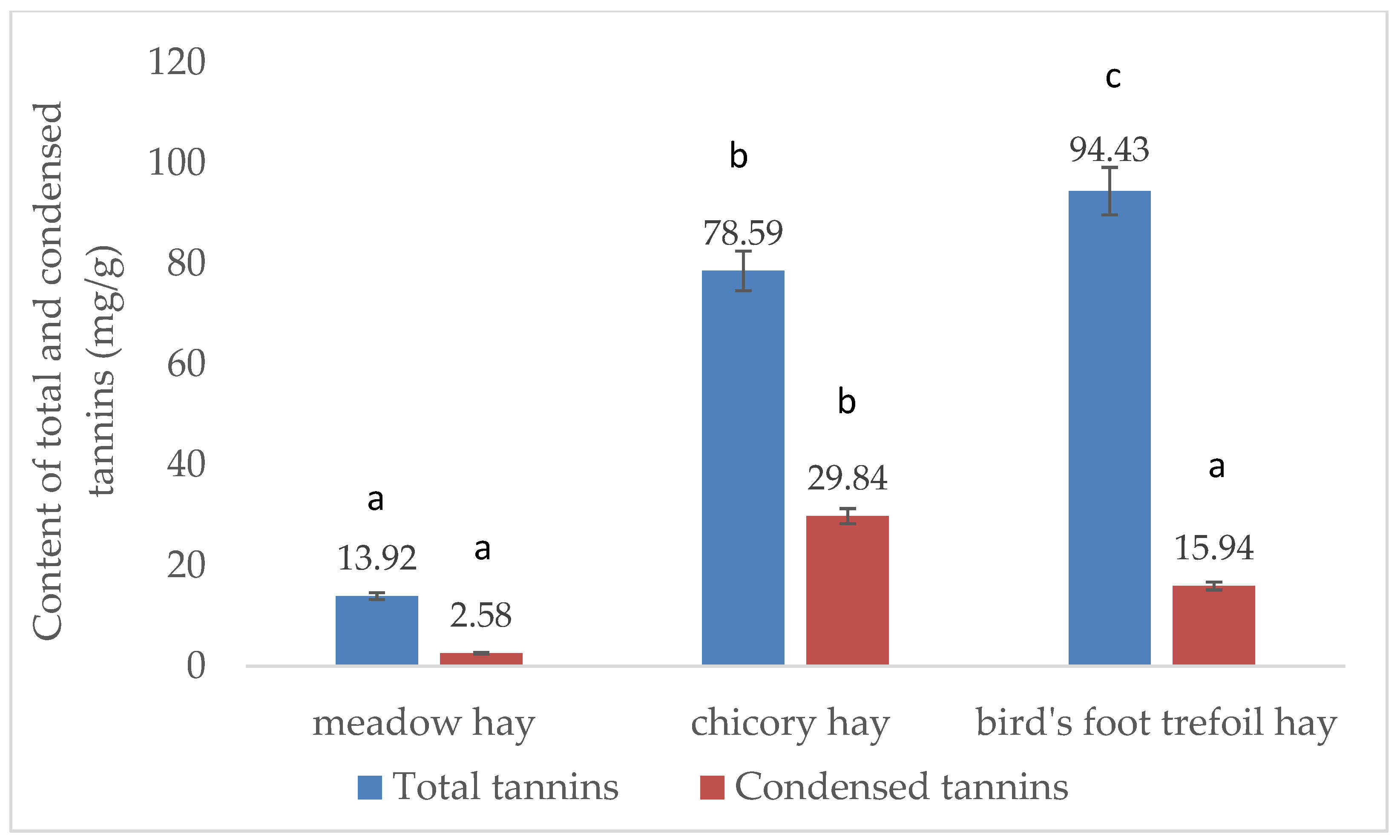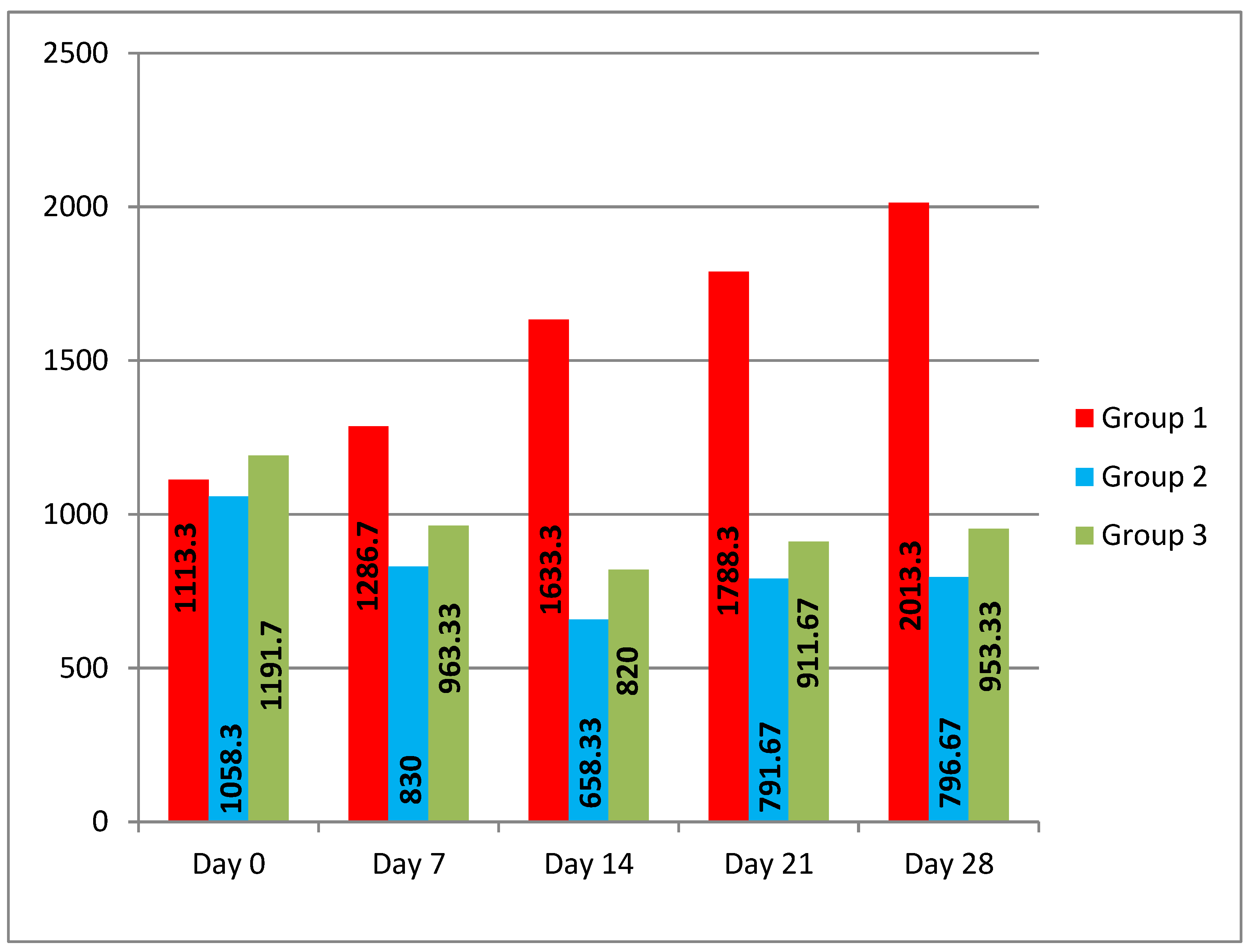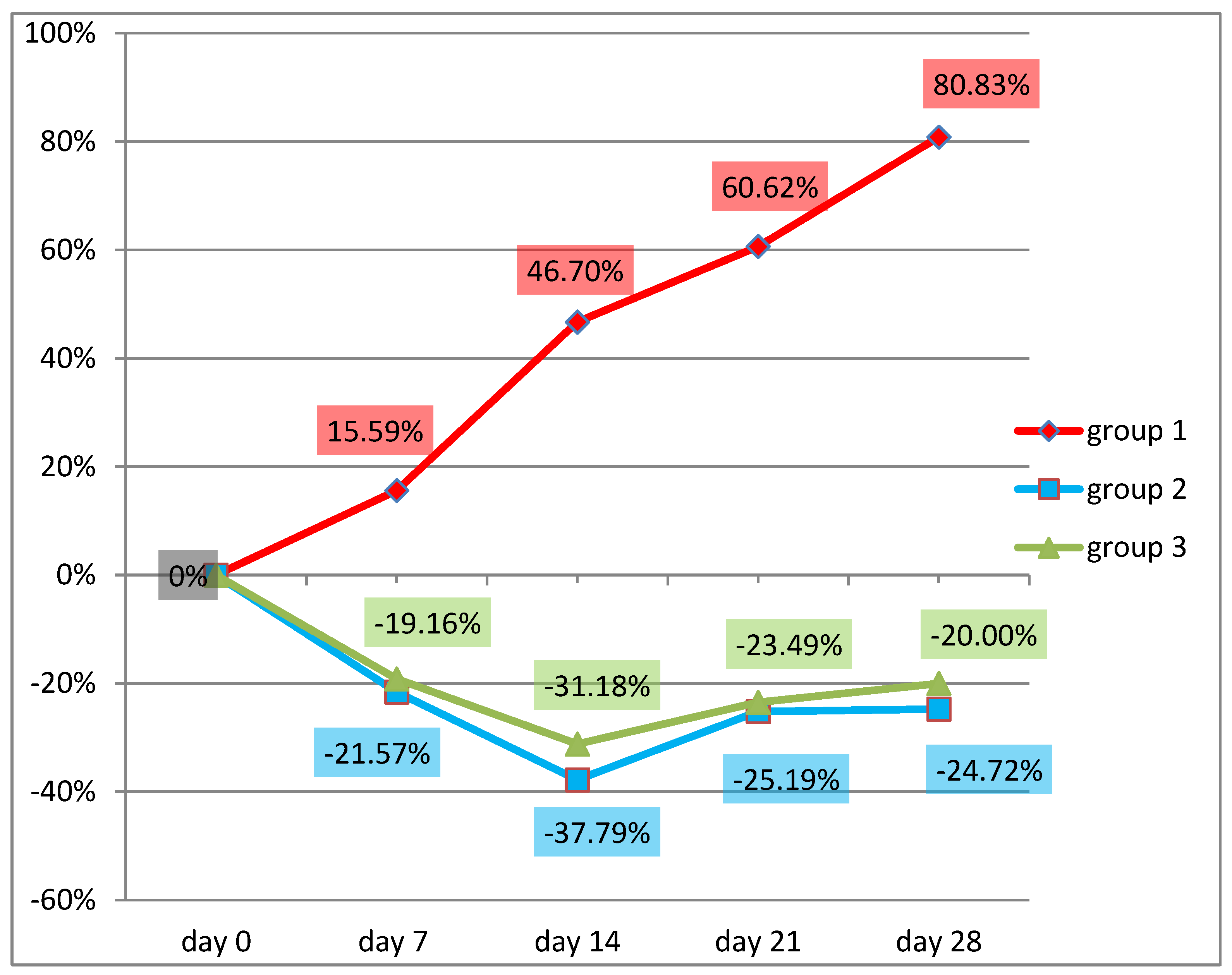Research on the Control of Gastrointestinal Strongyles in Sheep by Using Lotus corniculatus or Cichorium intybus in Feed
Abstract
1. Introduction
2. Materials and Methods
2.1. Ethic Statements
2.2. Determining the Total and Condensed Tannins
2.2.1. Extraction of Total Tannins
2.2.2. Determining Total Tannins
2.2.3. Extraction of Condensed Tannins
2.2.4. Determination of Condensed Tannins
2.2.5. Statistical Data Analysis
2.3. Control of Gastrointestinal Strongyles through Administration of Cichorium intybus and Lotus corniculatus Hay
2.3.1. Experimental Groups
- One meal of meadow hay of approximately 20 kg/group/day for the control group (group 1);
- One meal of chicory hay of approximately 20 kg/group/day for group 2;
- One meal of bird’s foot trefoil hay of approximately 20 kg/group/day for group 3.
2.3.2. Sample Collection and Examination
2.3.3. Statistical Data Analysis
3. Results
3.1. Determination of Total and Condensed Tannins
3.2. Control of Gastrointestinal Strongyles via Administration of Cichorium intybus and Lotus corniculatus Hay
4. Discussions
5. Conclusions
Author Contributions
Funding
Institutional Review Board Statement
Informed Consent Statement
Data Availability Statement
Acknowledgments
Conflicts of Interest
References
- Olmedo-Juarez, A.; Zarza-Albarran, M.A.; Rojo-Rubio, R.; Zamilpa, A.; Gonzalez-Cortazar, M.; Mondragon-Ancelmo, J.; Rivero-Perez, N.; Mendoza-De Givez, P. Acacia farnesiana pods (plant: Fabaceae) possesses anti-parasitic compounds against Haemonchus contortus in female lambs. Exp. Parasitol. 2020, 218, 107980. [Google Scholar] [CrossRef] [PubMed]
- Roeber, F.; Jex, A.R.; Gasser, R.B. Advances in the diagnosis of key gastrointestinal nematode infection of livestock, with an emphasis on small ruminants. Biotechnol. Adv. 2013, 31, 1135–1152. [Google Scholar] [CrossRef] [PubMed]
- Zajickova, M.; Nguyen, L.T.; Skalov, L.; Stuchlikov, L.R.; Matouskova, P. Anthelmintics in the future: Current trends in the discovery and development of new drugs against gastrointestinal nematodes. Drug Discov. Today 2020, 25, 430–437. [Google Scholar] [CrossRef] [PubMed]
- Bordes, L.; Dumont, N.; Lespine, A.; Souil, E.; Sutra, J.F.; Prevot, F.; Grisez, C.; Romanos, L.; Dailledouze, A.; Jacquiet, P. First report of multiple resistance to eprinomectin and benzimidazole in Haemonchus contortus on a dairy goat farm in France. Parasitol. Int. 2020, 76, 102063. [Google Scholar] [CrossRef] [PubMed]
- Aguerre, S.; Jacquiet, P.; Brodier, H.; Bournazel, J.P.; Grisez, C.; Prevot, F. Resistance to gastrointestinal nematodes in dairy sheep: Genetic variability and relevance of artificial infection of nucleus rams to select for resistant ewes on farms. Vet. Parasitol. 2018, 256, 16–23. [Google Scholar] [CrossRef]
- Acevedo-Ramirez, P.M.C.; Hallal-Calleros, C.; Flores-Pérez, I.; Alba-Hurtado, F.; Mendoza-Garfias, M.B.; Garajas, R. Nematicidal Effect and Histological Modifications Induced by Hydrolysable Tannin Extract on the Third-Stage Infective Larvae of Haemonchus contortus. Biology 2020, 9, 442. [Google Scholar] [CrossRef]
- Besier, R.B.; Kahn, L.P.; Sargison, N.D.; Van Wyk, J.A. Chapter Six—Diagnosis, treatment and management of Haemonchus contortus in small ruminants. Adv. Parasitol. 2016, 93, 181–238. [Google Scholar] [CrossRef]
- Arece-Garcia, J.; Lopez-Leyva, Y.; Olmedo-Juarez, A.; Ramirez-Vargas, G.; Reyes-Guerrero, D.; Lopez-Arellano, M.E.; Mendoza de Gives, P.; Rojo-Rubio, R.; Gonzalez-Gurdano, R. First report of multiple anthelmintic resistance in goat farm in Cuba. Helminthologia 2017, 54, 358–362. [Google Scholar] [CrossRef]
- Fiel, C.A.; Steffan, P.E.; Muchiuc, S.M.; Fernandez, A.S.; Bernat, G.; Riva, E.; Lloberas, M.M.; Almada, A.; Homer, D. An attempt to replace an ivermectin-resistant Cooperia spp. population by a susceptible one on grazing pastures based on epidemiological principles and refugia management. Vet. Parasitol. 2017, 246, 53–59. [Google Scholar] [CrossRef]
- Mondragon-Ancelmo, J.; Olmedo-Juarez, A.; Reyes-Guerrero, D.; Ramirez-Vargas, G.; Ariza-Roman, A.E.; Lopez-Arellano, M.E.; Mendoza de Gives, P.; Napolitano, F. Detection of gastrointestinal nematode populations resistant to Albendazole and Ivermectin in sheep. Animals 2019, 9, 775. [Google Scholar] [CrossRef] [PubMed]
- Ahnuir-Baraja, A.E.; Cibot, F.; Llobat, L.; Garijo, M.M. Antihelmintic resistance: Is a solution possible? Exp. Parasitol. 2021, 230, 108169. [Google Scholar] [CrossRef]
- Cezar, A.S.; Toscan, G.; Camillo, G.; Sangioni, L.A.; Ribas, H.O.; Vogel, F.S.F. Multiple resistance of gastrointestinal nematodes to nine different drugs in a sheep flock in southern Brazil. Vet. Parasitol. 2010, 173, 157–160. [Google Scholar] [CrossRef]
- Rose, H.; Rinaldi, L.; Bosco, A.; Mavrot, F.; De Waal, T.; Skuce, P.; Charlier, J.; Torgerson, P.R.; Hertzberg, H.; Hendrickx, G.; et al. Widespread anthelmintic resistance in European farmed ruminants: A systematic review. Vet. Rec. 2015, 176, 546. [Google Scholar] [CrossRef] [PubMed]
- Hrckova, G.; Velebny, S. Parasite helminths of humans and animals: Health impact and control. In Pharmacological Potential of Selected Natural Compounds in the Control of Parasitic Diseases; Springer: Vienna, Austria, 2013; pp. 29–99. [Google Scholar] [CrossRef]
- Heckendorn, F.; Haring, D.A.; Maurer, V.; Senn, M.; Hertzberg, H. Individual administration of three tanniferous forage plants to lambs artificially infected with Haemonchus contortus and Cooperia curticei. Vet. Parasitol. 2007, 146, 123–134. [Google Scholar] [CrossRef]
- Street, R.A.; Sidana, J.; Prinsloo, G. Cichorium intybus: Traditional uses, Phytochemistry, Pharmacology, and Toxicology. Evid. Based Complement Altern. Med. 2013, 579319. [Google Scholar] [CrossRef]
- Acharya, J.; Hildreth, M.B.; Reese, R.N. In vitro screening of forty medicinal plant extracts from the United States Northern Great Plains for anthelmintic activity against Haemonchus contortus. Vet. Parasitol. 2014, 201, 75–81. [Google Scholar] [CrossRef]
- Kpabi, I.; Munsch, T.; Agban, A.; Ther-Kone, I.; Dorat, J.; Boudesocque-Delaye, L.; Delaye, P.O.; Neveu, C.; Lanoue, A.; Enguehard-Gueiffier, C. Cassia sieberiana root bark used in traditional medicine in Togo: Anthelmintic property against Haemonchus contortus and tannins composition. South Afr. J. Bot. 2022, 151, 549–558. [Google Scholar] [CrossRef]
- Peña-Espinoza, M.; Valente, A.H.; Thamsborg, S.T.; Simonsen, H.T.; Boas, U.; Enemark, H.L.; Lopez-Muñoz, R.; Williams, A.R. Antiparasitic activity of chicory (Cichorium intybus) and its natural bioactive compounds in livestock: A review. Parasites Vectors 2018, 11, 475. [Google Scholar] [CrossRef] [PubMed]
- Casler, M.D.; Undersander, D.J. Identification of temperate pasture grassesand legumes. In Horse Pasture Management; Academic Press: London, UK, 2019; pp. 11–35. [Google Scholar] [CrossRef]
- Ramirez-Restrepo, T.A.; Barry, W.E.; Pomroy, N.; Lopez-Villalobos, W.C.; Kempc, P.D. Use of Lotus corniculatus containing condensed tannins to increase summer lamb growth under commercial dryland farming conditions with minimal anthelmintic drench input. Anim. Feed Sci. Technol. 2005, 122, 197–217. [Google Scholar] [CrossRef]
- Novobilski, A.; Mueller-Harveyc, I.; Thamsborga, S.M. Condensed tannins act against cattle nematodes. Vet. Parasitol. 2011, 182, 213–220. [Google Scholar] [CrossRef]
- Terrill, T.H.; Millerb, J.E.; Burkec, J.M.; Mosijidisd, J.A.; Kaplene, R.M. Experiences with integrated concepts for the control of Haemonchus contortus in sheep and goats in the United States. Vet. Parasitol. 2012, 186, 28–37. [Google Scholar] [CrossRef] [PubMed]
- Huang, Q.; Liu, X.; Zhao, G.; Hu, T.; Wang, Y. Potential and challenges of tannins as an alternative to in-feed antibiotics for farm animal production. Anim. Nutr. 2018, 4, 137–150. [Google Scholar] [CrossRef] [PubMed]
- Petchidurai, G.; Nagoth, J.A.; John, M.S.; Sahayaraj, K.; Murugesan, N.; Pucciarelli, S. Standardization and quantification of total tannins, condensed tannin and soluble phlorotannins extracted from thirty-two drifted coastal macroalgae using high performance liquid chromatography. Bioresour. Technol. Rep. 2019, 7, 100273. [Google Scholar] [CrossRef]
- Makkar, H.P.S. Effects of fate of tannins in ruminant animals, adaptations to tannins and strategies to overcome detrimental effect of feeding tannin-rich feeds. Small Rumin. Res. 2003, 49, 241–256. [Google Scholar] [CrossRef]
- Coles, G.; Bauer, C.; Borgsteede, F.; Geerts, S.; Klei, T.; Taylor, M.; Waller, P. World Association for the Advancement of Veterinary Parasitology (W.A.A.V.P.) methods for the detection of anthelmintic resistance in nematodes of veterinary importance. Vet. Parasitol. 1992, 44, 35–44. [Google Scholar]
- Dărăbuș, G.; Oprescu, I.; Morariu, S.; Mederle, N.; Ilie, M. Ghid Practic in Bolile Parazitare; Agroprint USAMVBT: Timișoara, România, 2013; Volume 1, pp. 16–17. [Google Scholar]
- Byers, S.R.; Kramer, J.W. Normal hematology of sheep and goats. In Schalm’s Veterinary Hematology, 6th ed.; Wiley-Blackwell: Ames, IA, USA, 2010; pp. 836–842. [Google Scholar]
- Scharenberg, A.; Arrigo, Y.; Gutzwiller, A.; Soliva, C.R.; Wyss, U.; Kreuzer, M.; Dohme, F. Palatability in sheep and in vitro nutritional value of dried and ensiled sainfoin (Onobrychis viciifolia) birdsfoot trefoil (Lotus corniculatus), and chicory (Cichorium intybus). Arch. Anim. Nutr. 2007, 61, 6. [Google Scholar] [CrossRef]
- Cireșan, C.A.; Oprescu, I.; Imre, M.; Suici, T.; Cărpinișan, L.; Dărăbuș, G. Preliminary research on the control of gastrointestinal strongyles in sheep, using Lotus corniculatus. Sci. Parasitol. 2021, 22, 44–49. [Google Scholar]
- Juhnke, J.; Miller, J.; Hall, J.O.; Provenza, F.D.; Villalba, J.J. Preference for condensed tannins by sheep in response to challenge infection with Haemonchus contortus. Vet. Parasitol. 2012, 188, 104–114. [Google Scholar] [CrossRef]
- Ketzis, J.K.; Vercruysse, J.; Stromberg, B.E.; Larsen, M.; Athanasiadou, S.; Houdijk, G.M. Evaluation of efficacy expectations for novel and non-chemical helminth control strategies in ruminants. Vet. Parasitol. 2006, 139, 321–335. [Google Scholar] [CrossRef]
- Wang, Y.; Douglas, G.; Waghorn, G.; Barry, T.; Foote, A. Effect of condensed tannins in Lotus corniculatus upon lactation performance in ewes. J. Agric. Sci. 1996, 126, 353–362. [Google Scholar] [CrossRef]
- Marley, C.L.; Fraser, M.D.; Fychan, R.; Theobald, V.J.; Jones, R. Effect of forage legumes and anthelmintic treatment on the performance, nutritional status and nematode parasites of grazing lambs. Vet. Parasitol. 2005, 131, 267–282. [Google Scholar] [CrossRef] [PubMed]
- Lima, P.M.T.; Crouzoulon, P.; Sanches, T.P.; Zabré, G.; Kabore, A.; Niderkorn, V.; Hoste, H.; Amarante, A.F.T.D.; Costa-Júnior, L.M.; Abdalla, A.L.; et al. Effects of Acacia mearnsii supplementation on nutrition, parasitological, blood parameters and methane emissions in Santa Inês sheep infected with Trichostrongylus colubriformis and Haemonchus contortus. Exp. Parastol. 2019, 207, 107777. [Google Scholar] [CrossRef]
- Ramirez-Restrepo, T.A.; Barry, W.E.; Pomroy, N.; Lopez-Villalobos, W.C.; Shawb, R.J.; Heinb, W.R. Characterization of immune responses against gastrointestinal nematodes in weaned lambs grazing willow fodder blocks. Anim. Feed. Sci. Technol. 2010, 155, 99–110. [Google Scholar] [CrossRef]
- Min, B.R.; Hart, S.P.; Miller, D.; Tomita, G.M.; Loetz, E.; Sahlu, T. The effect of grazing forage containing condensed tannins on gastro-intestinal parasite infection and milk composition in Angora does. Vet. Parasitol. 2005, 130, 105–113. [Google Scholar] [CrossRef] [PubMed]
- Paolini, V.; Bergeaud, J.P.; Grisez, C.; Prevot, F.; Dorchies, P.H.; Hoste, H. Effects of condensed tannins on goats experimentally infected with Haemonchus contortus. Vet. Parasitol. 2003, 113, 253–261. [Google Scholar] [CrossRef]



| Group 1 (Control)—Meadow Hay | Group 2—Chicory Hay | Group 3—Bird’s Foot Trefoil Hay | ||||
|---|---|---|---|---|---|---|
| day 0 | day 28 | day 0 | day 28 | day 0 | day 28 | |
| Total Kg/group | 1372.5 | 1359.5 | 1339 | 1383.4 | 1357.9 | 1406.3 |
| Minimum individual weight | 40.2 | 40.2 | 39 | 40.2 | 40.4 | 41.5 |
| Maximum individual weight | 49.6 | 50 | 49.6 | 52.2 | 49.1 | 49.5 |
| Mean | 45.75 | 45.31 | 45.26 | 46.87 | 44.63 | 46.11 |
| Standard deviation | 3.04 | 2.84 | 3.41 | 3.52 | 2.81 | 2.32 |
| Mean standard error | ±0.55 | ±0.51 | ±0.62 | ±0.64 | ±0.51 | ±0.42 |
| Group 1 (Control)—Meadow Hay | |||||
| day 0 | day 7 | day 14 | day 21 | day 28 | |
| Total EPG/group | 33,400 | 38,600 | 49,000 | 53,650 | 60,400 |
| Minimum | 0 | 0 | 0 | 0 | 300 |
| Maximum | 2550 | 2550 | 3000 | 3650 | 3950 |
| EPG average/animal | 1113.3 a | 1286.7 a | 1633.3 a | 1788.3 a | 2013.3 a |
| Standard deviation | 632.31 | 627.93 | 811.7 | 871.06 | 945.13 |
| Mean standard error | ±115.44 | ±114.64 | ±148.19 | ±159.03 | ±172.56 |
| Group 2—Chicory Hay | |||||
| day 0 | day 7 | day 14 | day 21 | day 28 | |
| Total EPG/group | 31,750 | 24,900 | 19,750 | 23,750 | 23,900 |
| Minimum | 0 | 0 | 0 | 0 | 0 |
| Maximum | 3250 | 1900 | 1650 | 2000 | 1750 |
| EPG average/animal | 1058.3 a | 830 b | 658.33 b | 791.67 b | 796.67 b |
| Standard deviation | 695.81 | 513.54 | 370.95 | 506.52 | 485.29 |
| Mean standard error | ±127.04 | ±93.759 | ±67.725 | ±92.478 | ±88.601 |
| Group 3—Bird’s Foot Trefoil Hay | |||||
| day 0 | day 7 | day 14 | day 21 | day 28 | |
| Total EPG/group | 35,750 | 28,900 | 24,600 | 27,350 | 28,600 |
| Minimum | 0 | 0 | 0 | 0 | 0 |
| Maximum | 2750 | 2450 | 1850 | 1750 | 1850 |
| EPG average/animal | 1191.7 a | 963.33 b | 820 b | 911.67 b | 953.33 b |
| Standard deviation | 619.8 | 595.95 | 517.55 | 533.48 | 511.41 |
| Mean standard error | ±113.16 | ±108.81 | ±94.492 | ±97.4 | ±93.37 |
| Group 1 (Control)—Meadow Hay | ||||
| day 0 | day 14 | day 28 | Ref. | |
| n | 5 | 5 | 5 | |
| RBC (×106/mL) | 9.81 ± 1.69 | 8.17 ± 1.56 | 7.56 ± 1.37 | 9–15 |
| HGB (g/dL) | 10.7 ± 1.81 | 9.4 ± 1.81 | 9.3 ± 2.05 | 9–15 |
| PCV (%) | 27.2 ± 3.45 | 25.2 ± 2.35 | 27.5 ± 4.63 | 27–45 |
| WBC (×103/mL) | 8.98 ± 2.38 | 8.85 ± 2.18 | 13.39 ± 4.77 | 4–12 |
| Group 2—Chicory Hay | ||||
| day 0 | day 14 | day 28 | Ref. | |
| RBC (×106/mL) | 9.8 ± 3.32 | 10.08 ± 1.88 | 11.36 ± 3.03 | 9–15 |
| HGB (g/dL) | 12.6 ± 2.98 | 11.4 ± 2.21 | 11.8 ± 2.73 | 9–15 |
| PCV (%) | 34.5 ± 6.45 | 30.6 ± 9.31 | 30.6 ± 6.47 | 27–45 |
| WBC (×103/mL) | 10.42 ± 3.21 | 12.1 ± 3.05 | 12.19 ± 2.86 | 4–12 |
| Group 3—Bird’s Foot Trefoil Hay | ||||
| day 0 | day 14 | day 28 | Ref. | |
| RBC (×106/mL) | 10.12 ± 1.70 | 9.53 ± 1.35 | 10.69 ± 3.32 | 9–15 |
| HGB (g/dL) | 11.6 ± 1.77 | 11.1 ± 1.07 | 11.2 ± 3.35 | 9–15 |
| PCV (%) | 30 ± 2.19 | 28.7 ± 3.61 | 30.5 ± 4.38 | 27–45 |
| WBC (×103/mL) | 10.96 ± 1.34 | 10.72 ± 3.31 | 10.87 ± 4.42 | 4–12 |
Disclaimer/Publisher’s Note: The statements, opinions and data contained in all publications are solely those of the individual author(s) and contributor(s) and not of MDPI and/or the editor(s). MDPI and/or the editor(s) disclaim responsibility for any injury to people or property resulting from any ideas, methods, instructions or products referred to in the content. |
© 2023 by the authors. Licensee MDPI, Basel, Switzerland. This article is an open access article distributed under the terms and conditions of the Creative Commons Attribution (CC BY) license (https://creativecommons.org/licenses/by/4.0/).
Share and Cite
Cireșan, C.-A.; Cocan, I.; Alexa, E.; Cărpinișan, L.; Sîrbu, C.B.; Obiștioiu, D.; Jitea, B.A.-M.; Florea, T.; Dărăbuș, G. Research on the Control of Gastrointestinal Strongyles in Sheep by Using Lotus corniculatus or Cichorium intybus in Feed. Pathogens 2023, 12, 986. https://doi.org/10.3390/pathogens12080986
Cireșan C-A, Cocan I, Alexa E, Cărpinișan L, Sîrbu CB, Obiștioiu D, Jitea BA-M, Florea T, Dărăbuș G. Research on the Control of Gastrointestinal Strongyles in Sheep by Using Lotus corniculatus or Cichorium intybus in Feed. Pathogens. 2023; 12(8):986. https://doi.org/10.3390/pathogens12080986
Chicago/Turabian StyleCireșan, Călin-Alexandru, Ileana Cocan, Ersilia Alexa, Liliana Cărpinișan, Cătălin Bogdan Sîrbu, Diana Obiștioiu, Beatrice Ana-Maria Jitea, Tiana Florea, and Gheorghe Dărăbuș. 2023. "Research on the Control of Gastrointestinal Strongyles in Sheep by Using Lotus corniculatus or Cichorium intybus in Feed" Pathogens 12, no. 8: 986. https://doi.org/10.3390/pathogens12080986
APA StyleCireșan, C.-A., Cocan, I., Alexa, E., Cărpinișan, L., Sîrbu, C. B., Obiștioiu, D., Jitea, B. A.-M., Florea, T., & Dărăbuș, G. (2023). Research on the Control of Gastrointestinal Strongyles in Sheep by Using Lotus corniculatus or Cichorium intybus in Feed. Pathogens, 12(8), 986. https://doi.org/10.3390/pathogens12080986








